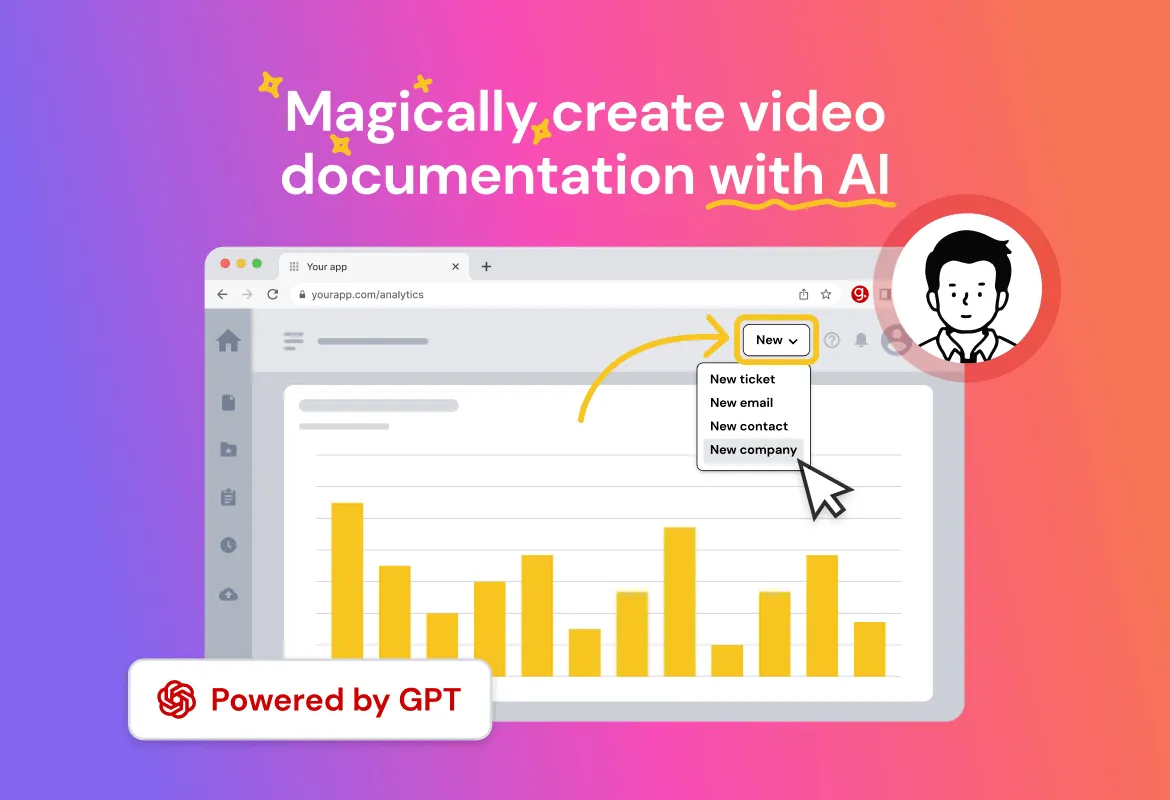Leveraging Videos for Employee Training in Customer Service
Future-proof your customer service with engaging video training. Equip your team with the skills they need to delight clients today and tomorrow.
Updated February 19, 2024.

Traditional customer service training methods like manuals and lectures often struggle to engage employees and translate theory into practice. As a result, your staff needs to work harder to connect with customers, resolve issues, and leave a positive impression.
Videos capture attention better than text, which makes learning more enjoyable and impactful. You can simulate talking with clients and help employees refine communication, empathy, and problem-solving skills by using them for employee training.
Upgrade Your Customer Service Training: The Visual Learning Advantage
Communicating clearly is essential in customer service, and videos effectively train employees for this vital skill. Studies show that it boosts knowledge retention, making it particularly effective for teaching communication techniques.
Because visual learning is so versatile, you can cover various customer service topics, from general ways of communicating to specific examples doing it effectively.
Note: Using guidde, your employees can create a knowledge base with recordings of themselves roleplaying customer interactions, or capture demonstrations of best practices.
Benefits of Using Videos for Customer Service Training
- Training videos capture attention better than text, increasing employee engagement and knowledge retention.
- Consistent delivery of training content across geographically dispersed teams is important, and videos are accessible anytime.
- Visual learning and storytelling foster better knowledge retention than traditional methods.
- They can recreate real-life customer interactions for practical skills practice.
Mirror, Mirror on the Screen: Emotionally Intelligent Customer Service
Videos act as virtual mirrors, reflecting diverse customer interactions. By observing these scenarios, employees learn to recognize emotional cues and think of appropriate responses.
They also show effective communication techniques. Employees can watch and practice adapting their language to customer needs, ensuring clear and respectful interactions.
Finally, video training shows the process of identifying, analyzing, and resolving customer objections in various scenarios. It equips employees with the tools to tackle challenges confidently because they can watch different approaches and practice applying them in simulated scenarios.
» Find out why your customer support process needs video
Your Guide to Creating Customer Service Training Videos
Before diving into video training, clear planning is crucial. You should know precisely what your employees need to learn and how you'll achieve it.
Here's how you can do it:
- Start by defining clear learning objectives. What specific skills or knowledge do you want your employees to gain? Scripting out desired outcomes helps ensure focused training.
- Identify the specific situations your employees need to be prepared for. Listing these scenarios helps you select relevant examples and structure your training effectively.
- Craft a clear and logical structure for your training. This includes organizing information, appropriately pacing content, and breaking complex topics into smaller, digestible segments.
Tip: Our attention spans are limited. Keep your videos concise and to the point. Focus on delivering essential information without unnecessary fluff.
Strategic Rollout and Tracking Guide for Maximum Impact
Once your training video is ready, consider how you'll deliver it to your employees and track their progress.
Single Video:
- Distribution: Communicate where to place the video, whether on a website, internal server, or learning management system (LMS).
- Confirmation: Implement a system to acknowledge completion, such as a confirmation email or quiz.
- Tracking: Use analytics or a system that records views to monitor engagement.
Video Series:
- Rollout Strategy: Consider a gradual rollout for teams unfamiliar with video training to avoid overwhelming them.
- Accessibility: Ensure everyone can access the videos, regardless of technical limitations.
- Centralized Location: Store the videos in a single, easily accessible location (e.g., LMS) and notify everyone.
- Tracking: Implement a tracking system to monitor who has completed each video in the series.
» Learn what customer enablement is and how you can benefit from it
How Real-Life Stories Elevate Your Customer Service Training
Real-life examples are the golden ticket for customer service training. They bridge the gap between theory and practice, helping you and your employees understand complex concepts and hone skills effectively.
Imagine your employees watching a video where they encounter a real-life customer service scenario. They see how theoretical knowledge translates into practical application, understanding different situations and their appropriate responses.
By offering opportunities to choose the video's outcome based on customer interaction options, your employees actively participate, simulating real-world challenges and reinforcing decision-making skills.
Enter the Future: My Immersive Journey with VR Training
The tech world is booming, particularly with AI and virtual reality (VR) advancements. Recently, I was a part of VR training firsthand, which was engaging and remarkably effective.
Employees wore VR goggles, immersing themselves in realistic customer service scenarios and practicing their skills in a safe and controlled environment. That's what this training offers.
This approach makes learning fun and interactive, boosts knowledge retention, and prepares employees for real-world interactions. Think about it: actively practicing responses in a VR simulation feels far more impactful than reading from a page.
Note: While my experience involved small group sessions, VR training can be adapted to various group sizes and training needs.
» Learn to measure employee training effectiveness
Invest in Visual Learning, Invest in Success
Keep your customer service team from being held back by outdated methods. By embracing the power of visual learning through video training, you can equip your employees with the skills and confidence they need to excel.
But how do you create an effective customer service training program? That's where guidde comes in. It's a powerful platform designed to help you capture compelling training videos for your customer service team. You can even share or embed them via secure links in your LMS.

